The White-throated Needletail (Hirundapus caudacutus) is a remarkable bird renowned for its swift flight and unique characteristics.
Belonging to the swift family Apodidae, this species exhibits fascinating behavioral adaptations that allow it to thrive in various habitats across Asia, Australia, and the Pacific region.
With its distinctive white throat patch, sleek aerodynamic body, and agile aerial maneuvers, the White-throated needleletail captures the imagination of bird enthusiasts and researchers alike.
From its communal nesting habits to its gregarious social behavior and extensive migrations, this bird exemplifies nature’s ingenuity and adaptability.
Understanding the ecological significance and conservation needs of the White-throated Needletail is essential for ensuring the preservation of this captivating species for future generations. Stay sharp.
Pick Out Criteria of White-throated Needletail
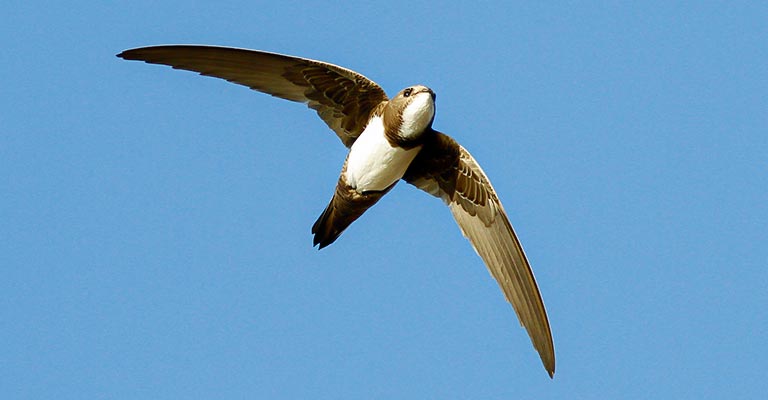
The White-throated Needletail (Hirundapus caudacutus) is a striking bird known for its swift flight and distinctive features. Here are eight critical criteria to identify this specific bird:
Size and Shape
White-throated Needletails are medium- to large-sized swifts with wingspans ranging from 45 to 55 centimeters (18 to 22 inches). They have a sleek, aerodynamic shape with long, pointed wings and a short, slightly forked tail.
Coloration
The upper parts of the White-throated needleletail are predominantly dark brown to blackish, while the underparts are paler, often with a grayish or whitish tone.
The throat is white, a distinguishing feature that gives the bird its name.
Flight Style
One of the most characteristic features of White-throated needleletails is their rapid and agile flight.
They are incredibly swift flyers, capable of precision maneuvering even at high speeds. Their flight pattern often appears erratic, with sudden changes in direction and altitude as they chase insects in flight.
Voice
While White-throated Needletails are generally silent outside of the breeding season, they may produce soft, high-pitched calls during courtship or when near their nests. However, their vocalizations are not a reliable identification feature.
Habitat
White-throated Needletails are typically found in open habitats, including grasslands, savannas, and forest clearings.
They are commonly associated with areas where large swarms of flying insects, such as termites and ants, are abundant.
Range and Distribution
The White-throated Needletail has a wide distribution across parts of Asia, Australia, and the Pacific region.
During the breeding season, they inhabit temperate and subtropical regions, while in the non-breeding season, they may migrate to warmer climates.
Behavior
In addition to their remarkable flight abilities, White-throated Needletails are known for their gregarious behavior, often forming large flocks, especially during migration.
They are highly social birds and may be observed flying and feeding together in coordinated groups.
Seasonality
Depending on their location, White-throated needleletails may be observed year-round in some regions, while in others, they are migratory and only present during certain seasons.
Understanding their seasonal movements can aid in their identification.
To identify a White-throated Needletail in the field, observing its distinctive flight style, looking for the white-throat patch, and considering factors such as habitat, behavior, and seasonal occurrence are essential.
Additionally, consulting a reliable field guide or birding app can provide valuable information and aid in confirming the bird’s identification.
Taking note of these critical criteria will enhance your ability to recognize and appreciate this fascinating species in its natural environment.
Taxonomy of White-throated Needletail

Check out the table below summarizing the taxonomy details of Swifts based on the provided information:
| Taxonomic Level | Classification |
| Domain | Eukaryota |
| Kingdom | Animalia |
| Phylum | Chordata |
| Class | Aves |
| Clade | Strisores |
| Order | Apodiformes |
| Family | Apodidae |
| Genus | Hirundapus |
| Species | H. caudacutus |
The White-throated Needletail (Hirundapus caudacutus) belongs to the family Apodidae, which encompasses swifts and swiftlets.
Within the order of Apodiformes, they are classified as part of the subfamily Apodinae. Hirundapus includes several species of swifts known for their rapid flight and aerial hunting abilities.
The specific epithet “caudacutus” refers to their distinctive forked tail. Taxonomically, White-throated Needletails are closely related to other swift species, sharing common ancestry and ecological adaptations for aerial life.
Their taxonomic classification provides insights into their evolutionary history and relationships with other avian species.
Reproduction of White-throated Needletail
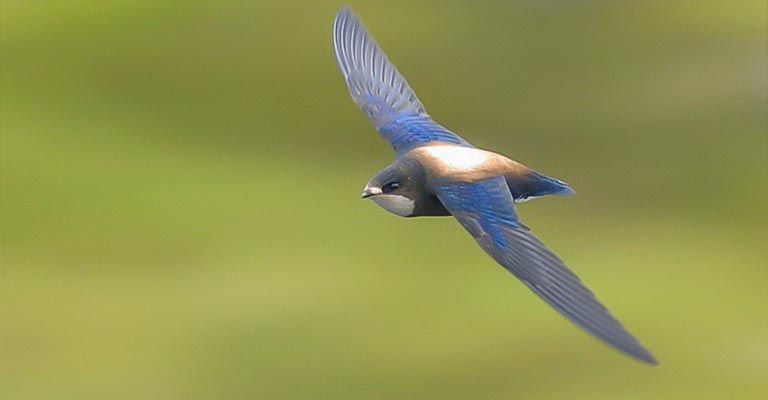
The White-throated Needletail’s reproduction process is characterized by its colonial nesting habits and seasonal breeding behavior.
During the breeding season, typically in spring and summer, these birds form breeding colonies in suitable habitats such as cliffs, caves, or hollow trees.
Breeding Colonies
White-throated Needletails typically breed in colonies, often nesting in cliffs, caves, or tree hollows.
These colonies can consist of several pairs of breeding individuals, providing safety in numbers and communal defense against predators.
Single Egg Clutches
Female White-throated Needletails typically lay a single egg per clutch. The eggs are usually smooth, glossy, and white or creamy with brown or gray speckles.
This reproductive strategy allows the parents to focus their energy on caring for and raising a single offspring at a time.
Incubation and Nestling Period
Both parents take turns incubating the egg, which lasts approximately 18-21 days.
Once hatched, the nestling period lasts around 5-6 weeks, during which time both parents feed the chick with regurgitated food, ensuring its growth and development.
Multiple Broods
Depending on environmental conditions and food availability, White-throated Needletails may raise multiple broods in a single breeding season.
This flexibility in reproductive behavior allows them to maximize their breeding success and population growth under favorable conditions.
They construct cup-shaped nests using various materials, including feathers, twigs, and plant fibers, often glued together with their saliva.
Female Needletails lay a single egg per clutch, which both parents take turns incubating for around 18 to 21 days. Once hatched, both parents participate in feeding the chick with regurgitated food.
The young birds proliferate and fledge after approximately 5 to 6 weeks. White-throated Needletails may raise multiple broods in a single breeding season, depending on food availability and environmental conditions.
White-throated Needletail Life History
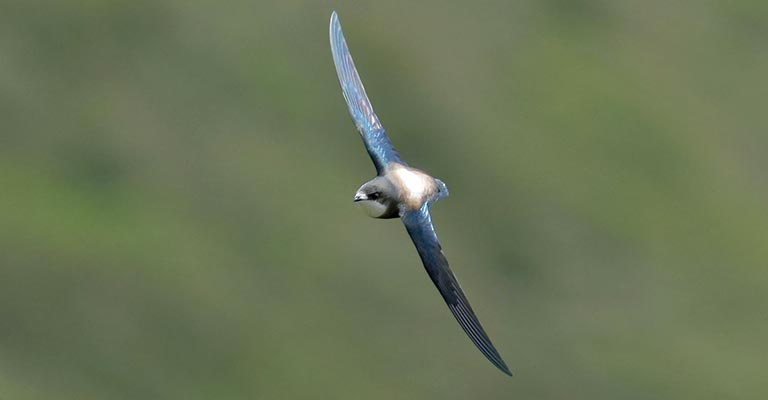
The White-throated Needletail (Hirundapus caudacutus) is a fascinating bird renowned for its swift flight and unique features. Understanding its life history provides insights into its ecological niche and conservation needs.
Food
White-throated Needletails are insectivorous birds that feed on flying insects such as termites, ants, beetles, and flies.
Their agile flight allows them to catch prey on the wing, often performing impressive aerial maneuvers to capture their food.
They are known to forage in open habitats with abundant insect populations, including grasslands, savannas, and forest clearings.
Habitat
These birds inhabit many habitats across Asia, Australia, and the Pacific. They are commonly found in open landscapes with access to suitable nesting sites and ample insect prey.
While they may breed in temperate and subtropical regions, they may migrate to warmer areas during the non-breeding season.
Range Map
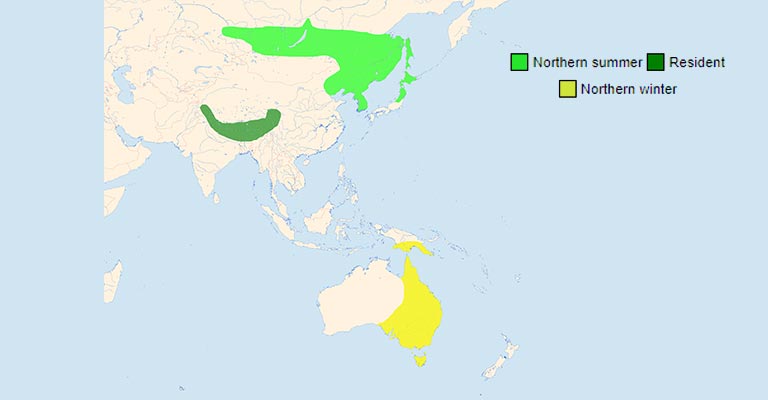
A range map illustrates the distribution of White-throated Needletails across their breeding and non-breeding ranges, highlighting critical areas of occurrence and migration routes.
Nesting
White-throated Needletails are colonial nesters, forming breeding colonies in cliffs, caves, or tree hollows.
They construct cup-shaped nests using a combination of feathers, twigs, and plant fibers cemented with their saliva.
Female Needletails typically lay a single egg per clutch, and both parents take turns incubating the egg and feeding the chick once hatched.
Check out the below-mentioned table below detailing the nesting details of the White-throated Needletail:
| Nesting Details | Facts |
| Clutch Size | Typically 1 egg per clutch |
| Number of Broods | May raise multiple broods in a breeding season |
| Egg Length | Approximately 20-25 mm |
| Egg Width | Approximately 13-15 mm |
| Incubation Period | Around 18-21 days |
| Nestling Period | Approximately 5-6 weeks |
| Egg Description | Smooth, glossy surface, usually white or creamy with brown or gray speckles |
| Nest Description | Cup-shaped nest made of feathers, twigs, and plant fibers, cemented together with saliva |
These details provide insights into the reproductive behavior and characteristics of the White-throated Needletail, aiding in their understanding and conservation.
White-throated Needletails are colonial nesters, forming breeding colonies in cliffs, caves, or tree hollows. They construct cup-shaped nests using feathers, twigs, and plant fibers cemented with saliva.
Female Needletails typically lay a single egg per clutch, and both parents take turns incubating the egg, which lasts around 18-21 days. Once hatched, both parents participate in feeding the chick with regurgitated food.
The young birds proliferate and fledge after approximately 5-6 weeks. This nesting habit allows communal breeding and contributes to the species’ social structure and reproductive success.
Diseases
While relatively resilient, White-throated Needletails may be susceptible to diseases commonly affecting birds, such as avian influenza, Newcastle disease, and West Nile virus.
Parasites like mites and lice can also affect their health and reproductive success.
Treatment
Treating diseases and parasites in White-throated Needletails involves veterinary care, including diagnosis, medication, and supportive therapy.
Conservation efforts may include monitoring for disease outbreaks and implementing measures to mitigate their impact on populations.
Conservation
Conservation of White-throated Needletails involves protecting their habitats and addressing threats such as habitat loss, climate change, and disturbance at breeding sites.
Research on their ecology and migration patterns is crucial for informing conservation strategies and ensuring the long-term survival of this remarkable species.
The life history of the White-throated Needletail is essential for conserving this species and maintaining the ecological balance of its habitats.
5 Behavioral Habits of White-throated Needletail
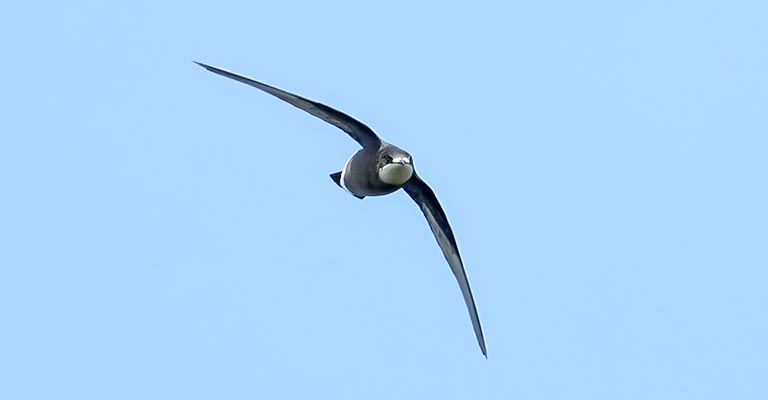
Understanding the behavioral habits of the White-throated Needletail (Hirundapus caudacutus) provides insights into its unique adaptations and ecological role.
Aerial Foraging
White-throated Needletails exhibit remarkable aerial foraging behavior, capturing flying insects such as termites and ants while in flight.
Their swift and agile flight allows them to maneuver precisely, making them highly efficient predators in the air.
Gregariousness
These birds are highly social and often form large flocks, especially during migration. Their gregarious nature not only aids in finding food but also provides safety in numbers against predators and facilitates breeding activities.
Communal Nesting
White-throated Needletails engage in communal nesting, forming breeding colonies in cliffs, caves, or tree hollows.
This behavior allows for cooperative breeding efforts, with multiple individuals contributing to the construction and maintenance of nests and the care of offspring.
High-Speed Flight Displays
White-throated Needletails engage in high-speed flight displays characterized by rapid aerial maneuvers and vocalizations during courtship and territorial displays.
These displays serve to attract mates and establish dominance within their social groups.
Long-Distance Migration
White-throated Needletails are known for their extensive migrations, traveling thousands of kilometers between breeding and non-breeding grounds.
Their ability to undertake long-distance flights highlights their remarkable endurance and navigational skills, which are essential for survival in changing environments.
Wrapping Up
So, the White-throated Needletail is a fascinating bird with unique behavioral adaptations that enable it to thrive in diverse environments.
This species exemplifies nature’s ingenuity and resilience, from its aerial foraging prowess to its communal nesting habits and long-distance migrations.
By studying and appreciating the behavioral habits of the White-throated Needletail, we gain valuable insights into the complexities of avian life and the importance of conservation efforts to protect these remarkable birds for future generations.